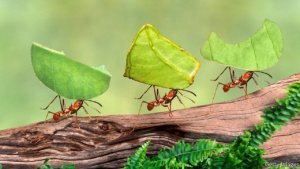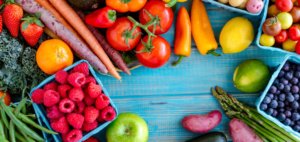Reading Passage 1 – Ant Intelligence
You should spend about 30 minutes on Questions 1-13, which are based on Reading Passage below.

When we think of intelligent members of the animal kingdom, the creatures that spring immediately to mind are apes and monkeys. But in fact, the social lives of some members of the insect kingdom are sufficiently complex to suggest more than a hint of intelligence. Among these, the world of the ant has come in for considerable scrutiny lately, and the idea that ants demonstrate sparks of cognition has certainly not been rejected by those involved in these investigations.
Ants store food, repel attackers and use chemical signals to contact one another in case of attack. Such chemical communication can be compared to the human use of visual and auditory channels (as in religious chants, advertising images and jingles, political slogans and martial music) to arouse and propagate moods and attitudes. The biologist Lewis Thomas wrote Ants are so much like human beings as to be an embarrassment. They farm fungi, raise aphids as livestock, launch armies to war, use chemical sprays to alarm and confuse enemies, capture slaves, engage in child labour, exchange information ceaselessly. They do everything but watch television.
* aphids: small insects of a different species from ants
However, in ants there is no cultural transmission – everything must be encoded in the genes – whereas In humans the opposite is true. Only basic instincts are carried in the genes of a newborn baby, other skills being learned from others in the community as the child grows up. It may seem that this cultural continuity gives us a huge advantage over ants. They have never mastered fire nor progressed. Their fungus farming and aphid herding crafts are sophisticated when compared to the agricultural skills of humans five thousand years ago but have been totally overtaken by modem human agribusiness.
Or have they? The farming methods of ants are at least sustainable. They do not ruin environments or use enormous amounts of energy. Moreover, recent evidence suggests that the crop farming of ants may be more sophisticated and adaptable than was thought.
Ants were farmers fifty million years before humans were. Ants can’t digest the cellulose in leaves – but some fungi can. The ants, therefore, cultivate these fungi in their nests, bringing them leaves to feed on, and then use them as a source of food. Farmer ants secrete antibiotics to control other fungi that might act as ‘weeds’, and spread waste to fertilise the crop.
It was once thought that the fungus that ants cultivate was a single type that they had propagated, essentially unchanged from the distant past. Not so. Ulrich Mueller of Maryland and his colleagues genetically screened 862 different types of fungi taken from ants’ nests. These turned out to be highly diverse: it seems that ants are continually domesticating new species. Even more impressively, DNA analysis of the fungi suggests that the ants improve or modify the fungi by regularly swapping and sharing strains with neighboring ant colonies.
Whereas prehistoric man had no exposure to urban lifestyles – the forcing house, of intelligence – the evidence suggests that ants have lived in urban settings for close on a hundred million years, developing and maintaining underground cities of specialised chambers and tunnels.
When we survey Mexico City, Tokyo, Los Angeles, we are amazed at what has been accomplished by humans. Yet Hoelldobler and Wilson’s magnificent work for ant lovers, the Ants, describes a supercolony of the ant Formica yessensis on the Ishikari Coast of Hokkaido. This ‘megalopolis’ was reported to be composed of 360 million workers and a million queens living in 4,500 interconnected nests across a territory of 2.7 square kilometers.
Such enduring and intricately meshed levels of technical achievement outstrip by far anything achieved by our distant ancestors. We hail as masterpieces the cave paintings in southern France and elsewhere, dating back some 20,000 years. Ant societies existed in something like their present form more than seventy million years ago. Beside this, prehistoric man looks technologically primitive. Is this then some kind of intelligence, albeit of a different kind?
Research conducted at Oxford, Sussex and Zurich Universities has shown that when; desert ants return from a foraging trip, they navigate by integrating bearings and distances, which they continuously update their heads. They combine the evidence of visual landmarks with a mental library of local directions, all within a framework which is consulted and updated. So ants can learn too.
And in a twelve-year programme of work, Ryabko and Reznikova have found evidence that ants can transmit very complex messages. Scouts who had located food in a maze returned to mobilise their foraging teams. They engaged in contact sessions, at the end of which the scout was removed in order to observe what her team might do. Often the foragers proceeded to the exact spot in the maze where the food had been Elaborate precautions were taken to prevent the foraging team using odour clues. Discussion now centers on whether the route through the maze is communicated as a ‘left- right sequence of turns or as a ‘compass bearing and distance’ message.
During the course of this exhaustive study, Reznikova has grown so attached to her laboratory ants that she feels she knows them as individuals – even without the paint spots used to mark them. It’s no surprise that Edward Wilson, in his essay, ‘In the company of ants’, advises readers who ask what to do with the ants in their kitchen to: ‘Watch where you step. Be careful of little lives.’
Reading Passage 2 – The True Cost of Food
You should spend about 30 minutes on Questions 14-26, which are base on Reading Passage 2 below:
 A For more than forty years the cost of food has been rising. It has now reached a point where a growing number of people believe that it is far too high and that bringing it down will be one of the great challenges of the twenty-first century. That cost, however, is not in immediate cash. In the West at least, most food is now far cheaper to buy in relative terms than it was in 1960. The cost is in the collateral damage of the very methods of food production that have made the food cheaper: in the pollution of water, the enervation of soil, the destruction of wildlife, the harm to animal welfare and the threat to human health caused by modern industrial agriculture. First mechanisation, then mass use of chemical fertilisers and pesticides, then monocultures, then battery rearing of livestock, and now genetic engineering– the onward march of intensive farming has seemed unstoppable in the last half-century, as the yields of produce have soared. But the damage it has caused has been colossal. In Britain, for example, many of our best-loved farmland birds, such as the skylark, the grey partridge, the lapwing and the corn bunting, have vanished from huge stretches of countryside, as have even more wild-flowers and insects. This is a direct result of the way we have produced our food in the last four decades. Thousands of miles of hedgerows, thousands of ponds have disappeared from the landscape. The faecal filth of salmon farming has driven wild salmon from many of the sea lochs and rivers of Scotland. Natural soil fertility is dropping in many areas because of continuous industrial fertiliser and pesticide use, while the growth of algae is increasing in lakes because of the fertiliser run-off.
A For more than forty years the cost of food has been rising. It has now reached a point where a growing number of people believe that it is far too high and that bringing it down will be one of the great challenges of the twenty-first century. That cost, however, is not in immediate cash. In the West at least, most food is now far cheaper to buy in relative terms than it was in 1960. The cost is in the collateral damage of the very methods of food production that have made the food cheaper: in the pollution of water, the enervation of soil, the destruction of wildlife, the harm to animal welfare and the threat to human health caused by modern industrial agriculture. First mechanisation, then mass use of chemical fertilisers and pesticides, then monocultures, then battery rearing of livestock, and now genetic engineering– the onward march of intensive farming has seemed unstoppable in the last half-century, as the yields of produce have soared. But the damage it has caused has been colossal. In Britain, for example, many of our best-loved farmland birds, such as the skylark, the grey partridge, the lapwing and the corn bunting, have vanished from huge stretches of countryside, as have even more wild-flowers and insects. This is a direct result of the way we have produced our food in the last four decades. Thousands of miles of hedgerows, thousands of ponds have disappeared from the landscape. The faecal filth of salmon farming has driven wild salmon from many of the sea lochs and rivers of Scotland. Natural soil fertility is dropping in many areas because of continuous industrial fertiliser and pesticide use, while the growth of algae is increasing in lakes because of the fertiliser run-off.
E The costs included: £120m for removal of pesticides; £16m for removal of nitrates; £55m for removal of phosphates and soil; £23m for the removal of the bug cryptosporidium from drinking water by water companies; £125m for damage to wildlife habitats, hedgerows and dry stone walls; £1,113m from emissions of gases likely to contribute to climate change; £106m from soil erosion and organic carbon losses; £169m from food poisoning; and £607m from cattle disease. Professor Pretty draws a simple but memorable conclusion from all this: our food bills are actually threefold. We are paying for our supposedly cheaper food in three separate ways: once over the counter, secondly through our taxes, which provide the enormous subsidies propping up modern intensive farming, and thirdly to clean up the mess that modern farming leaves behind. F So can the true cost of food be brought down? Breaking away from industrial agriculture as the solution to hunger may be very hard for some countries, but in Britain, where the immediate need to supply food is less urgent, and the costs and the damage of intensive farming have been clearly seen, it may be more feasible. The government needs to create sustainable, competitive and diverse farming and food sectors, which will contribute to a thriving and sustainable rural economy, and advance environmental, economic, health, and animal welfare goals. G But if industrial agriculture is to be replaced, what is a viable alternative? Professor Pretty feels that organic farming would be too big a jump in thinking and in practices for many farmers. Furthermore, the price premium would put the product out of reach of many poorer consumers. He is recommending the immediate introduction of a ‘Greener Food Standard’, which would push the market towards more sustainable environmental practices than the current norm, while not requiring the full commitment to organic production. Such a standard would comprise agreed practices for different kinds of farming, covering agrochemical use, soil health, land management, water and energy use, food safety and animal health. It could go a long way, he says, to shifting consumers as well as farmers towards a more sustainable system of agriculture.
You need to be registered and logged in to take this quiz. Log in
